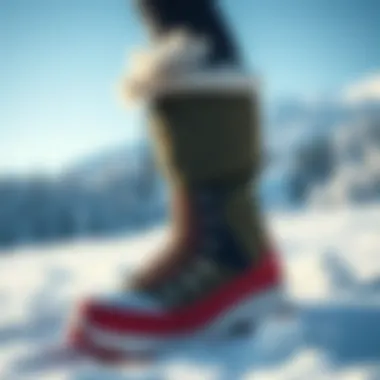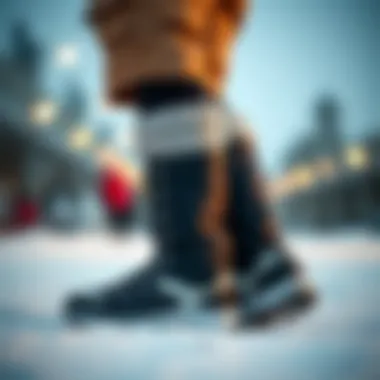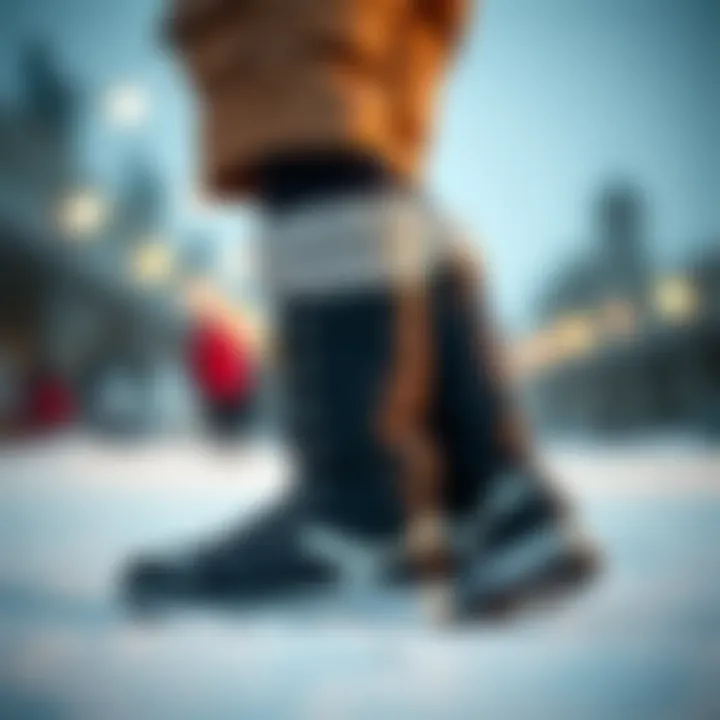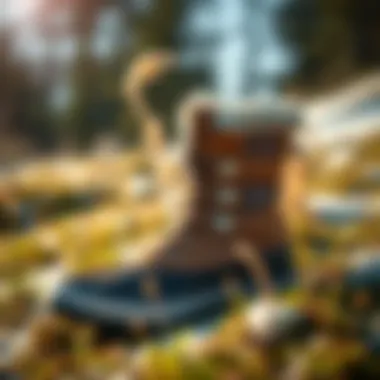Snow Overshoes: Balancing Functionality and Style


Intro
During the frosty, picture-perfect days of winter, finding the right footwear can make all the difference when it comes to comfort and style. Say hello to snow overshoes: the unsung heroes of winter wardrobes, merging utility with the latest trends. When the weather outside is frightful, these robust yet fashionable accessories offer insulation against the cold while making a statement.
Snow overshoes aren't just slam-on shoes wrapped in insulation; they're carefully designed pieces that cater to varied conditions and preferences. With some crafted from cutting-edge, weather-resistant materials, and others showcasing bold aesthetics, there is no denying that their role goes beyond functionality alone.
As we dive into snow overshoes, this guide will journey through their unique designs, the current fashion trends they embody, and the expertise needed to select the perfect pair. Alongside this, we will delve into maintenance practices, highlight essential styling tips, and discuss sustainable practices in the realm of winter footwear. This comprehensive resource will prepare you to walk through winter in both comfort and style.
Understanding Snow Overshoes
When winter rolls in and blankets the landscape in a shimmering layer of snow, keeping your feet warm and dry becomes crucial. This is where snow overshoes come into play. A pivotal component of winter wear, these specialized footwear items not only enhance comfort but also address practical concerns specific to harsh weather conditions. With a variety of designs and functionalities, understanding snow overshoes is essential for anyone venturing outdoors during the cold months.
Definition and Purpose
So, what exactly are snow overshoes? In simple terms, they are protective footwear designed to be worn over regular shoes or boots. Their primary purpose is to provide a barrier against snow, slush, and moisture while adding insulated warmth. Think of them as the middleman between your everyday footwear and the unforgiving winter elements. When equipped with the right pair, you're not just protecting your feet from getting soggy, but you're also enhancing your stability on icy surfaces. In chilly environments, the risk of frostbite isn’t just an old wives’ tale. Snow overshoes can offer insulation to keep your toes toasty, reducing the risk of cold-related injuries.
Historical Context
The history of snow overshoes is as layered as the snow drifts themselves. Traditionally, communities in colder climates have crafted their own versions for generations, leading to a fascinating evolution in design and functionality. For instance, indigenous peoples of the Arctic created durable footwear out of animal hides, specifically designed to trap warmth and repel moisture. As society progressed, so too did the materials and technology involved in creating these essential items. By the 20th century, the introduction of synthetic materials changed the game entirely, making snow overshoes not just practical but also increasingly stylish and accessible. Highlighting their evolution illustrates how they transitioned from mere necessity to a statement piece in winter fashion.
Current Relevance
In today’s world, snow overshoes retain significant relevance, bridging the gap between necessity and style. With climate change leading to unpredictable weather patterns, having a reliable pair of snow overshoes is more important than ever. Urban dwellers navigating snowy streets or adventurers exploring remote winter landscapes can improve their mobility and comfort greatly with the right footwear. Furthermore, the modern consumer is increasingly conscious of fashion, leading to the emergence of designs that don't compromise aesthetics for functionality. Thus, the current market features snow overshoes that align with contemporary fashion trends, appealing to a diverse range of consumers. They have become not just protective gear, but a canvas for designers looking to merge cold-weather practicality with flair.
"With the right snow overshoes, you're not just stepping out; you're stepping up your winter game."
Equipped with an understanding of snow overshoes, it's clear these winter essentials deserve more attention in both the realms of utility and fashion. As we continue on this exploration, we’ll delve deeper into their design features, providing a complete picture of what makes snow overshoes both functional and fashionable.
Design Features of Snow Overshoes
When it comes to snow overshoes, the design features play a vital role in determining functionality and style. These features are not just about looking good; they are key to ensuring comfort, durability, and performance in harsh winter conditions. Each element of the design works together to provide a seamless experience for the wearer, making it essential to delve into the specifics.
Materials Used
Waterproof Fabrics
The fabric used in snow overshoes significantly impacts their performance, especially when it comes to waterproofing. The primary characteristic of waterproof fabrics is their ability to repel moisture, keeping your feet dry even when trudging through deep snow or slushy puddles. One notable example of waterproof fabric is Gore-Tex, which boasts breathability and even moisture wicking properties while preventing water escape. This makes it a popular choice for brands like Salomon and Columbia.
However, not all waterproof fabrics are created equal. Some might be more durable against tearing but less flexible, while others may provide excellent flexibility but are prone to quick wear and tear in rugged conditions. Evaluating these aspects before purchasing can save consumers from discomfort and dissatisfaction.
Insulation Technologies
Next up, insulation technologies are crucial for maintaining warmth, especially in extremely cold regions. Insulation in snow overshoes often involves materials like Thinsulate or PrimaLoft, which are lightweight yet effective at trapping heat. What sets these materials apart is their unique structure that provides warmth without bulk, allowing for comfortable movements.
These technologies are favored because they also manage moisture inside. If your feet sweat, the insulation can help wick that moisture away, preventing cold feet from that dreaded chill of wet socks. However, choosing the wrong insulation can lead to overheating—so there’s always a balance to strike between warmth and breathability.
Sustainable Materials
Sustainability is becoming increasingly important in the fashion world, and snow overshoes are no exception. Many brands are now turning to eco-friendly materials, such as recycled plastics and organic cotton, which not only benefit the planet but also appeal to consumers who are conscious of their environmental footprint. For example, shoes made with recycled rubber soles not only keep waste out of landfills but also often come with comparable performance to traditional materials.
Yet, choosing sustainable materials can sometimes mean a trade-off in durability. While these materials offer a lesser environmental impact, the lifespan of the shoes might differ, so it's essential for consumers to weigh their values against performance needs.
Cushioning and Support
Ankle Support Design
Ankle support is an often-overlooked feature that can make all the difference in a pair of snow overshoes. The design of the ankle support is aimed at preventing injury while enhancing stability on uneven terrains. Brands like North Face utilize higher cuts or additional padding around the ankle to provide desired support.


One significant advantage of good ankle support is reduced fatigue—especially when traversing uneven ground or deep snow. However, some users may find overly rigid designs restrict movements, which could limit performance for those engaged in more active winter sports.
Footbed Technology
The footbed technology integrated into snow overshoes significantly enhances comfort and overall experience. Advanced footbeds often utilize gel or memory foam materials that mold to the foot's shape, providing personalized support. This customization leads to better distribution of weight across the shoe.
While these cushions can make long treks a breeze, they sometimes come at the cost of flexibility. A rigid footbed, while offering support, can limit the natural flexibility needed for more dynamic movements in winter activities.
Traction Systems
Studded Soles
Studded soles are a game changer when it comes to maintaining traction on slippery surfaces. These designs feature protrusions that grip into snow or ice, preventing slips and falls. This feature is particularly beneficial for those who live in cities that don’t clear walkways promptly during winter months.
However, the effectiveness of studded soles can be influenced by the type of terrain they are designed for. While they excel on snow and ice, they might not provide the same performance on hard, rocky ground, requiring wearers to consider where they plan to use their overshoes most.
Grip Technologies
Several innovative grip technologies have emerged that enhance traction without the need for physical studs. These often involve specialized rubber compounds that increase friction against icy or snowy surfaces. Brands may use names like Vibram for their proprietary grip systems, which excel under varying conditions.
While these systems can perform admirably across diverse environments, they may also change the feel of the shoe. Some wearers might prefer the more traditional studded models, so personal tastes and requirements become essential in making a choice.
"Choosing the right snow overshoes involves understanding the unique features that contribute to comfort, performance, and style."
Selecting the Right Pair
Choosing the right pair of snow overshoes is something that can really make or break your winter outdoor experience. These specialized footwear pieces not only protect your feet from the harsh elements but also affect how comfortable and mobile you feel while navigating through snow-covered landscapes. When it comes to finding the best fit for your needs, there are several aspects that deserve your attention. By taking the time to assess your requirements, measure correctly, and budget adequately, you'll set yourself up for a winter of exploration and enjoyment.
Assessing Your Needs
Climate Considerations
When it comes to climates where temperatures drop drastically, or snow seems to never leave, evaluating climate considerations is paramount. Not every pair of snow overshoes will cope well with severe winter conditions. You'll want to focus on features like waterproof yet breathable materials which keep moisture at bay while allowing your feet to breathe. A beneficial choice here is to look for options that include thermal insulation or have water-repellent treatments, effectively keeping your feet warm and cozy during a long day outdoors.
Sometimes, overshoes come with additional insulation systems that can be a game changer in extremely cold areas. The unique feature to consider here is the thermal lining, which traps warmth without bulky weight, letting you stay active and comfortable. Yet, it’s also important to realize that more insulation may lead to additional weight. If you live in a transitional climate, consider lighter, more flexible materials that can adapt to varying conditions, but always err on the side of moisture resistance.
Usage Scenarios
Usage scenarios pertain to how you plan to use your snow overshoes, which plays a big role in your final decision. Whether you're trekking through deep snow on backcountry trails or casually walking in a city covered in a blanket of white, each scenario requires different features. For heavy winter trekking, look for boots with robust grips to navigate slippery surfaces—not just for safer footing but to avoid fatigue over time.
On the flip side, if your needs are more casual—such as a weekend stroll through a park—you might prioritize lighter options that don’t feel like lead weights on your feet. While a sturdy sole is vital for intense hiking, it might be overkill for light walks, possibly making the shoes feel clunky. Each scenario has unique fits and comforts; being clearly aware of your specific needs will help avoid buyer's remorse.
Sizing and Fit
Measuring for Snow Overshoes
Getting the size just right for your snow overshoes could mean the difference between comfort and discomfort. The process involves understanding your foot measurements, which typically includes length and width—the two essentials that are often overlooked. It's not just about picking your regular shoe size; snow overshoes can differ significantly from standard footwear. A key characteristic is accounting for the type of socks you plan to wear too; thicker socks necessitate a size up.
Measuring your feet in the evening, when they are slightly swollen, can yield the best results, as they will be larger than in the morning. In undersized boots, the discomfort can be intensified during long periods of wear, while too much space can lead to blisters from friction. Therefore, knowing how to measure and account for extra needs is a critical step.
Try-On Tips
When it comes to trying on snow overshoes, readiness becomes a priority. A common recommendation is to wear the type of socks you intend to use for winter enjoyment. This may seem trivial, but the type of socks can impact how well the footwear fits. One of the unique aspects of this step is testing the flexibility and movement inside the boot. Move your toes around and pay attention to whether the boot allows for natural foot function without being restrictive.
Remember to walk around a bit, feel the grip, and adjust how tight the laces or straps are. You want to ensure that the boots do not shift while you walk, a common nuisance that leads to poor performance in snow. The advantages of this type of fitting process cannot be overstated; taking the time to find that sweet spot can save painful experiences down the line.
Budgeting for Quality


Cost vs. Value
In the realm of snow overshoes, understanding the difference between cost and value is crucial. A higher price tag doesn’t always equal better performance, but cheaper options can lead to bigger problems, especially under challenging conditions. This article underscores the balance between investing in quality products and recognizing your personal constraints. A worthwhile investment usually means that you’ll get better materials, advanced technologies in insulation, and longer durability.
A well-crafted overshoe can last several winters, which can actually save you money in the long run. In contrast, purchasing cheaper pairs repeatedly due to wear and tear may initially appear less costly but ultimately can lead to higher expense. Therefore, researching wisely and knowing the unique features and their reliability can guide your budget successfully.
Long-Term Investment
Lastly, regarding long-term investment in snow footwear, consider how much you are willing to put down for long-lasting quality. While the upfront cost might seem daunting, especially for top-end brands, the durability and performance are often worth it. Features like waterproofing, high-quality insulation, and a solid grip will serve you well for many seasons, extending the life cycle of your investment.
A unique feature of investing in better-made overshoes is the technology behind waterproof seals and breathable membranes. They keep your feet dry while allowing perspiration to escape. This level of comfort translates directly into a more enjoyable experience during outdoor activities. The drawback, however, is that these features require advanced materials, which naturally push the price higher. Understanding this dynamic can help make smarter purchasing decisions that reflect your winter needs.
Winter Fashion Considerations
Winter fashion isn’t merely about keeping warm; it’s also about expressing one’s personal style, even when the temperatures drop. Snow overshoes play a crucial role in both functionality and fashion, allowing folks to traverse snowy landscapes without sacrificing their outfit’s flair. This article aims to highlight how to integrate these practical yet stylish additions into one’s wardrobe, emphasizing their importance in the scheme of winter attire.
Integrating Overshoes into Outfits
Layering Techniques
Layering is a pivotal aspect of winter fashion. It allows wearers to combine different clothing pieces harmoniously while ensuring warmth. In terms of snow overshoes, they can serve as a standout piece when paired with layered outfits. For instance, a simple pair of black overshoes can be expertly matched with thick woolen socks peeking out from under high-waisted pants, combining functionality with a fashionable twist.
A key characteristic of layering in winter is versatility. This approach grants individuals the ability to mix and match various materials and colors. Overshoes can be layered over both trousers and skirts, enhancing the overall aesthetic while locking in heat. One disadvantage, however, could be the bulkiness that comes from excessive layering. It’s essential to strike a balance and avoid looking cumbersome.
Color Coordination
When it comes to snow overshoes, color coordination plays a critical part in translating warmth into style. Choosing the right colors can elevate the simplicity of one’s outfit. Think earthy tones or even vibrant alliterations that catch the eye yet maintain a winter vibe. The choice of color could send various messages about the wearer’s personality or mood for the day.
The key aspect of color coordination with overshoes involves creating contrast with other elements of your outfit. For example, pairing bright red overshoes with muted tones can create a striking, modern look. This element can enhance visual appeal while simultaneously keeping one’s feet warm and dry. However, it’s vital to avoid clashing colors, which can disrupt an otherwise carefully curated style.
Seasonal Trends
Current Styles
In the realm of winter fashion, staying updated with current styles is a must for fashion-forward thinkers. As of late, snow overshoes are evolving into statement-making pieces, no longer an afterthought but rather a focus of attention in winter wardrobes. The current trend leans heavily toward sleek, minimalist designs that offer both aesthetic appeal and practicality. Popular brands are releasing models in diverse colors and materials, from traditional black to more adventurous patterns.
A prominent feature of current styles in overshoes is how they can bridge the gap between rugged functionality and urban chic. These boots offer excellent insulation and waterproof technology, while maintaining a fashionable silhouette. The downside tends to be a higher price point, where style and function often come at a premium, but the investment yields durable quality and versatility.
Predicted Trends
Looking ahead, we can anticipate an even greater shift in the evolution of snow overshoes fueled by innovation and sustainability. Emerging designers and brands are likely to prioritize eco-friendly materials, reflecting a growing consumer consciousness towards environmental responsibility. This trend towards greener practices could manifest in recycled materials or efficient manufacturing processes, aligning with consumer demands for sustainable fashion choices.
A defining characteristic of these predicted trends is the emphasis on both personalization and customization. Manufacturers might start providing options for customers to design their own overshoes, reflecting personal style while ensuring practicality for winter conditions. While this upcoming trend shines with creativity, it also presents challenges—ranging from production complexity to potential price hikes. Still, staying ahead of the curve in winter fashion could very well make it worth the extra effort.
In summary, understanding how to integrate snow overshoes into winter wardrobes through layering and color coordination adds significant value to one’s fashion sense. Adopting current styles while keeping an eye on predicted trends will not only enhance individuality but also align with the evolving landscape of winter fashion.
This knowledge empowers wearers to stride confidently through snowy terrains without compromising on style, making them the talk of the town this winter.
Caring for Snow Overshoes
Caring for snow overshoes is a crucial aspect that often gets overlooked in discussions about winter footwear. The right care not only extends the life of your overshoes but also preserves their functionality and appearance. In a world where sustainability and durability are gaining traction, taking the time to ensure your footwear remains in good condition can be seen as a commitment to responsible consumerism. This section will explore essential cleaning techniques and best practices for storage, helping you protect your investment and enjoy your time in snowy landscapes without the worry of damage or deterioration.
Cleaning Techniques
Cleaning your snow overshoes might seem like a mundane task, but it's vital for maintaining their integrity and safety. Over time, dirt, salt, and moisture can accumulate, potentially leading to wear and tear if not promptly addressed. Here are a few effective cleaning techniques:
- Remove Loose Debris: Begin by knocking your overshoes together to dislodge any built-up dirt or snow. A good shake goes a long way.
- Use a Soft Brush: For surface cleaning, employing a soft-bristled brush can effectively remove stubborn dirt without causing harm to the material. Regular brushing will help maintain their appearance.
- Soap and Water Solution: For more thorough cleaning, a mild soap mixed with warm water can do wonders. Dip a cloth or soft sponge into the solution and gently scrub the exterior of the overshoes. Watch out for areas where grime tends to build up—treat these spots with extra care.
- Dry Thoroughly: After cleaning, it’s important to allow your overshoes to dry completely before storing them. Avoid direct sunlight and high heat sources which can warp or degrade the material over time.


Keeping your overshoes in optimal shape not only enhances their aesthetic appeal but also ensures they perform well in the harshest conditions.
Storage Best Practices
Proper storage of your snow overshoes is just as essential as cleaning. When the snow melts and winter fades, how you store your footwear can significantly affect its longevity. Here are some best practices to keep them in tip-top shape:
- Dry Before Storing: Always ensure your overshoes are completely dry before placing them away for the season. Moisture can encourage mold and mildew, ruining both appearance and integrity.
- Choose the Right Environment: Store them in a cool, dry place where temperature fluctuations are minimal. Avoid attics or garages where conditions can be too extreme.
- Maintain Shape: Use shoe trees or stuff them with newspaper to maintain their shape during storage. This prevents the materials from becoming creased or warped.
- Airflow is Key: When possible, store your overshoes in breathable containers. Insulated bins or mesh bags can function well. This allows air circulation which helps to keep unwanted odors or moisture at bay.
By implementing these two essential practices of cleaning and proper storage, your snow overshoes will not only look good but also stand up to the rigors of winter adventure year after year.
For more tips on shoe care, consider visiting resources like Wikipedia or Reddit.
As hope for winter adventures calls, ensuring your snow overshoes are well-cared-for can make all the difference in how you experience the great outdoors.
Sustainable Practices in Overshoe Production
As we navigate the ever-changing landscape of fashion and commerce, it’s important to consider how our purchasing habits impact the environment. Snow overshoes, often an essential part of winter attire, are no exception. In this section, we delve into the sustainable practices surrounding the production of these vital pieces of footwear, focusing on the benefits and challenges associated with eco-conscious materials and ethical manufacturing methods.
Eco-Friendly Materials
Incorporating sustainable materials into snow overshoe manufacturing is not just a trend; it’s becoming an industry standard. Consumer awareness is rising, prompting brands to reevaluate their sourcing strategies. Materials like recycled plastics, organic cotton, and natural rubber are gaining traction. These options minimize the carbon footprint associated with traditional materials.
For instance, companies are now utilizing recycled PET—often found in plastic bottles—as a key textile. This method not only reduces waste but curtails oil consumption in the process. Benefits of utilizing eco-friendly materials include:
- Lower Environmental Impact: Reducing reliance on virgin resources.
- Increased Durability: Many sustainable materials are crafted to withstand harsh conditions, proving their worth in both functionality and longevity.
- Consumer Appeal: Shoppers are increasingly motivated by brands that prioritize sustainability, which can translate to higher sales.
Moreover, natural materials such as wool provide warmth, breathability, and a lower environmental cost, offering both climate comfort and a nod toward sustainability. However, challenges remain. Sourcing ethical materials can sometimes come with higher costs, which may restrict their initial adoption by all brands.
Ethical Manufacturing Processes
Beyond the materials used, the processes through which snow overshoes are produced hold equal significance in the realm of sustainability. Ethical manufacturing processes include ensuring fair labor practices, minimizing waste, and optimizing energy consumption.
Brands adopting these practices are often transparent about their supply chains, emphasizing how their products are made. Here are some key elements:
- Fair Labor Standards: Pay attention to worker conditions to ensure their rights and dignity are upheld.
- Green Production Practices: This involves utilizing renewable energy sources and minimizing water consumption. Some manufacturers are even employing a closed-loop system that recycles water used in their processes.
- Waste Reduction Initiatives: Innovative designs minimize scrap during production, and many companies have set up recycling programs for damaged or unsold products.
"Sustainable production is not just a choice but a necessity. Brands that neglect this aspect may find themselves left behind in the changing marketplace."
It’s crucial for brands and consumers alike to engage in ongoing discussions about the impact of fashion on our planet. This growing consciousness won’t just enhance the appeal of snow overshoes in the market; it can also prompt a broader shift towards more sustainable practices across the apparel industry. By prioritizing eco-friendly materials and ethical manufacturing processes, we contribute to a healthier environment while still enjoying the stylish and functional aspects of winter footwear.
Future Innovations in Winter Footwear
The landscape of winter footwear, especially snow overshoes, is poised for dynamic transformations. Understanding the trends and technologies that propel this evolution is vital for forward-thinking fashion designers and enthusiasts alike. As we focus on the future, several key elements stand out, illuminating the potential benefits and considerations that will shape the industry.
The importance of innovation in the realm of winter footwear cannot be overstated. Not only do emerging technologies aim to enhance functionality and comfort, but they also respond to the growing demand for sustainability within fashion. As consumers become more discerning, so too does the necessity for brands to adapt and introduce new solutions that meet both performance and ethical standards.
"Innovation distinguishes between a leader and a follower." – Steve Jobs
Emerging Technologies
In recent years, various cutting-edge technologies have started making waves in snow overshoe design. From smart fabrics that adapt to changing temperatures to integrated insulation systems that provide warmth without bulk, the advancements are nothing short of impressive. Some notable examples include:
- Phase Change Materials (PCMs): These materials absorb, store, and release heat based on temperature fluctuations. This ensures that the wearer remains comfortable, regardless of the weather changes.
- 3D Knitting: This technology allows for the creation of seamless, fitted overshoes that reduce material waste and improve comfort. The precise fit enhances both functionality and style, catering to the modern user's needs.
- Biodegradable Components: With a greater emphasis on environmental responsibility, brands are exploring the use of biodegradable materials. These include natural rubber and plant-based polymers that offer performance while minimizing ecological impact.
Each innovative element not only seeks to improve the user experience but also endeavors to respect the planet, setting the tone for a harmonious future in footwear.
Trends in Customization
Customization is increasingly becoming a staple in the fashion world, allowing individuals to express themselves through personalized products. In the realm of snow overshoes, this trend is prevalent and offers several exciting features. Here are key points that highlight how customization is shaping the future:
- Design Variability: Consumers can choose from a range of colors, patterns, and textural elements. This level of personalized design is not just a fashion statement but allows for functional adaptability based on different activities—from casual snow trekking to extreme sports.
- Fit Adjustments: Brands are integrating adjustable features such as customizable lacing systems or modifiable ankle heights. This ensures that each pair of overshoes offers optimal support, comfort, and stability tailored to individual requirements.
- Technology Integration: Some emerging designs incorporate technology features that consumers can personalize. This includes options for built-in warming elements or connectivity to apps that monitor conditions and adjusting features accordingly.
As winter footwear continues to evolve, the importance placed on innovation and customization ensures that each winter adventure can be both stylish and functional. Keeping an eye on these trends will prepare designers, retailers, and consumers to embrace the next generation of snow overshoes.















